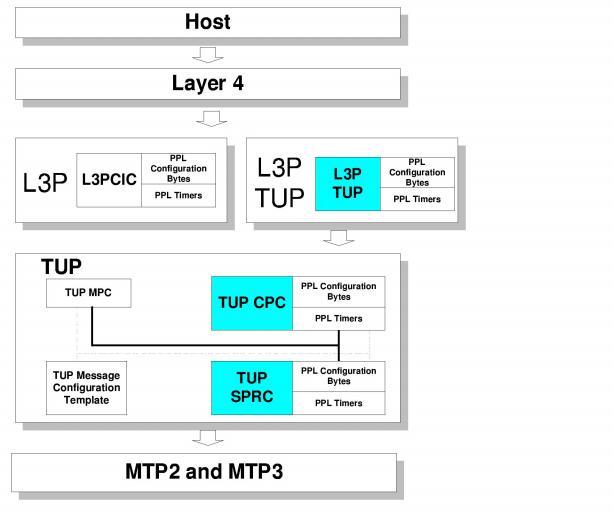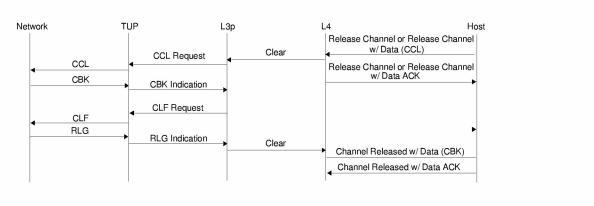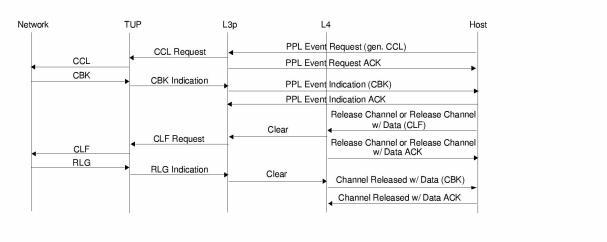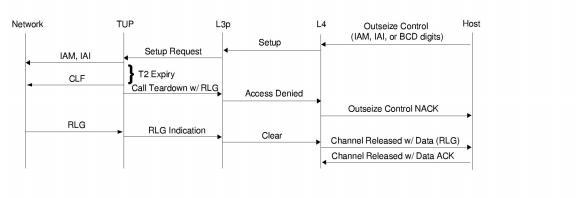
You are here: CSP Developer’s Guide: Common Channel Signaling > 5 TUP, BT IUP & SSUTR2 > TUP Outgoing Call Setup

Overview
This section describes TUP outgoing call setup.
This diagram illustrates the interaction between the host and the SS7 PPL components in the handling of an outgoing SS7 call. Shading identifies the software components involved in the call.

The Default Outgoing Call Sequence
The default outgoing call sequence is described in the table below. To customize the presentation of an incoming call, see SS7 Customization with ISUP Messages.
|
Stage |
Description |
|---|---|
|
1 |
An outgoing call is initiated by the host with the Outseize Control message. The Excel platform will accept address data as either BCD-encoded digits or in an SS7 TUP Formatted Fields ICB. The Outseize Control message drives L4 into an outseize state and an outseize request is sent to L3P TUP. |
|
2 |
L3P TUP translates the L4/L5 event into an TUP event. Any fields sent from L4/L5 are concatenated with pre-stored field data in the PPL Configuration Bytes. |
|
3 |
The fields and events are sent to the appropriate TUP Component. If field validation is successful, the fields are formatted into a raw SS7 message and sent to TUP SPRC. If validation fails, a PPL Event Indication message of Protocol Violation is sent to the host. |
|
4 |
TUP SPRC routes the message to MTP for transmission. |
This section includes call flows for outgoing call handling and release.
ANx = ANC, ANN, or ANU
The PPL Event Indication messages indicated by an asterisk (*) are not enabled by default. To enable indication of ACM, set Config Byte 1 of the L3P TUP component to 0x01. To enable indication of ANC/ANN/ANU set Config Byte 8 to 0x01.
Outgoing Call (Controlling Exchange) - Basic Call Setup

Outgoing Call (Controlling Exchange) - Call Unsuccessful

Outgoing Call (Controlling Exchange) Remote Clear-back Option1 (Default)

Outgoing Call (Controlling Exchange) Remote Clear-back Option II (Manual Handling)

Important! For this call flow, you must enable Config Byte 5 of the L3P TUP component to receive a PPL Event Indication (CBK).
Outgoing Call (Controlling Exchange) - Local Release

Outgoing Call (Not Controlling Exchange) - Local Calling Party Option I (Automatic Handling, Default)

Outgoing Call (Not Controlling Exchange) - Local Calling Party Clear Option II (Manual Handling)

Important! For this optional call flow, you must:
• Enable Config Byte 5 of the L3P TUP component to receive a PPL Event Indication (CBK).
• Send a PPL Event Request (CCL) message.
Outgoing Call (Controlling Exchange) - Remote Call Failure before ACM

Outgoing call (Controlling Exchange) - Remote Call Failure after ACM

Outgoing Call (Controlling Exchange) - Remote Call Unsuccessful

Outgoing Call (Controlling Exchange) - T2 (Wait for ACM) Expiration
